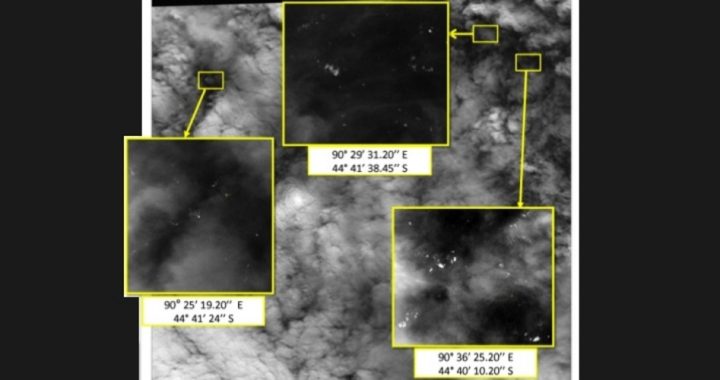
Two and a half weeks after Malaysia Airlines Flight MH370 disappeared without a trace about an hour after leaving Kuala Lumpur, Malaysia, on March 8, the discovery of 122 objects floating in the southern Indian Ocean by a French satellite provides newfound hope that the missing plane’s crash site may have been located.
The images (shown) were taken from a satellite operated by French-based Airbus Defence and Space on Sunday, were passed on to the Australian Rescue and Co-ordination Centre in Perth on Tuesday, and given to the Malaysian Remote Sensing Agency the same day.
However, authorities were quick to remind an anxious public that the debris has yet to be identified, so any assumption that the remains of Flight 370 have been found are premature. “It must be emphasized that we cannot tell whether the potential objects are from MH370,” said Hishammuddin Hussein, Malaysia’s minister of defense and acting minister of transport. “Nevertheless, this is another new lead that will help direct the search operation.” Hussein said the debris field was “clearly the most credible lead that we have.”
The objects photographed by the satellite, which ranged in size from about a yard to 75 feet in length, were scattered across 154 square miles of ocean. The area is about 1,588 miles west of Perth, Australia.
Aviation safety analyst David Soucie said in a statement quoted by CNN that he was particularly intrigued by the size of the 75-foot object. “It has potential to be a wing that’s floating,” he said. “So I’m really encouraged by it, I really am.”
CNN also quoted Mark Binskin, vice chief of the Australian Defence Force, who told the network’s Kate Bolduan on Tuesday, “There’s always a possibility we might not actually find something next week or the week after. I think eventually, something will come to light, but it’s going to take time.”
Time, unfortunately, is running out if search teams are to locate Flight 370. Like all commercial aircraft, it is equipped with an emergency locator transmitter, or ELT. The batteries powering Flight 370’s ELT, or “pinger,” are expected to run down within the next two weeks. Because the Indian Ocean has an average depth of about 13,000 feet, the signals from a submerged aircraft generally will not reach a satellite directly, but must be picked up by underwater listening devices.
The United States has deployed a Bluefin-21 — a torpedo-shaped, autonomous underwater vehicle, which can search for submerged objects at depths down to 14,700 feet — and a TPL-25 towed pinger locator. Both devices are used to locate the sonar “ping” from the underwater locator beacon that is fitted to the cockpit voice and flight data recorders installed in commercial aircraft. The TPL-25 can detect pings at a maximum depth of 20,000 feet.
The search teams include aircraft from six nations — the United States, Australia, China, Japan, South Korea, and New Zealand — but the remoteness of the area being searched, compounded with the bad weather in the region, presents challenges.
“The way the weather’s been out here, at 1,000 feet, we’d have virtually no visibility,” Lt. Com. Adam Schantz, a U.S. Navy pilot and the officer in charge of a Boeing P-8A Poseidon crew, told the Wall Street Journal. Like most teams involved in the search, the P-8A is based in Perth, Australia. Because the plane must fly several hours from Perth to the search area, it has only about three hours’ worth of fuel remaining before it must return to base.
A thousand feet is the optimum altitude for an aerial search, but because of the bad visibility, the P-8A has had to descend to just 300 feet. This writer remembers his father (an aviation radio man on a World War II-era PBY Catalina who participated in a search for five missing U.S. Navy TBM Avenger torpedo bombers off the Florida coast in 1945) telling him that as their plane climbed higher above the ocean, they could see deeper down into it.
Another factor hampering search teams in their search for the debris spotted by the satellite is the strong currents and high waves in the area, resulting from a recent tropical cyclone. Because of these conditions, any debris spotted would drift rapidly from its last known location. So, as of March 26, teams were yet to find the objects recorded by the satellite.
The next step in the search is to recover the floating objects and determine if they are from Malaysia Airlines Flight MH370. If they are, the next phase will begin — an underwater search operation to find the main components of the plane, including the flight data recorder, or “black box.” Such recoveries in deep ocean water have been made in the past, though they have sometimes taken years. Air France Flight 447 disappeared over the Atlantic on June 1, 2009 while on a flight from Rio de Janeiro to Paris. The plane’s fight data recorder was recovered on May 1, 2011, from ocean depths of 12,500 to 13,100 feet.
If the debris in the southern Indian Ocean turns out to be from Flight 370, it may only add to the mystery of why the plane was not only so far off course, but over 2,000 miles in the opposite direction of its previous heading from its last known position. To reach the suspected crash site, the plane would have had to have reversed course, and then flown for about four more hours. Such a radical change in course, which also indicates that the plane had not malfunctioned mechanically, suggests that the plane had been hijacked.
In an opinion piece in the March 17 Qatar-based al-Jazeera network, Tom Ballantyne, the chief correspondent of the Hong Kong-published Orient Aviation magazine, wrote that whichever theory about the fate of Flight 370 proves to be correct, “none of this happened by accident. Human hands, and ones familiar with the operation of the aircraft, were involved. Whether this was the pilot or pilots, or the crew operating under duress, remains to be seen.”
Photo of satellite imagery: AP Images
Related articles:
The Search for Malaysia Flight 370 Moves to the Indian Ocean
Search for Malaysia Airlines Flight 370 Yields Few Clues



